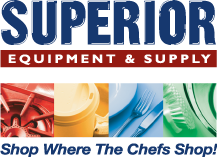
Food safety must be a top priority in every commercial kitchen and dining room. Failing to pass a health inspection or having customers become sick with foodborne illnesses can have devastating effects. Below are valuable tips on restaurant food safety to keep your staff and patrons healthy.
Front of House
Sanitize Surfaces: Ensure staff is properly sanitizing dining tables between settings. When using tablecloths, swap them out for a fresh one during the resetting of the table to prevent spreading of bacteria. Don’t use a tablecloth? Have your staff wipe down surfaces (include seats and menus) with a damp cloth and disinfectants. Local health codes outline approved disinfectants in your area.
Keep Prep Stations Clean: Having a designated area to prep and store flatware and dishes makes for easy resetting of the tables, however, these areas often get missed from the standard cleaning regimen. Bacteria and dust can settle in prep areas, making for unsanitary conditions. Consider adding the areas where you keep dishes and flatware to your cleaning schedule to regularly sanitize cutlery boxes and wipe down the surfaces.
Pay Attention to the Buffet: Buffets are notorious for being hot beds for cross contamination and bacterial growth, often making them the culprit in many foodborne illnesses. Keep your buffet both appetizing and safe by adhering to proper hot and cold food temperatures with the use of thermometers.
Stick to the 2 Hour Rule: Remember to discard any perishables that have been left out at room temperature for more than two hours. This applies to catered events, buffets and leftovers. Assign a staff member to watch over food stations to make sure food products are swapped out as needed. Also, train wait staff to caution guests to refrigerate their leftovers within two hours when handing over to-go boxes.
Trade the Old for New: For buffets and catered affairs, do not add food to pans that have been sitting out; instead switch out the entire pan. While this may increase the volume of clean up, it goes a long way in preventing guests from ingesting compromised foods at unsafe temperatures.
Back of House
Stay in the Safe Zone: When you prepare or store food, keep temperatures below 41°F or above 135°F. Any temperature that falls in between will welcome growth of harmful bacteria. Be on the alert to limit the time for thawing frozen meats or fish – never let them sit unattended on the counter. The USDA offers safety guidelines for properly thawing your proteins.
Headline on Hygiene: Hold regular trainings for your kitchen and wait staff on proper hygiene measures. This can range from when to wear hair nets and gloves to proper hand-washing techniques. By routinely bringing up safety measures, good hygiene will become second nature. Don’t forget to post hand washing signs in all restrooms.
Follow the First In, First Out Rule: When receiving a shipment of supplies bring older supplies to the front and place new food products near the back. This will ensure older items get used before expiring, minimizing food waste and risks that come with cooking food too close to their end dates. Food labels are an easy way to note when an item was received and the expiration date.
Maintain the Equipment and Workspaces: Routine cleaning of your equipment and prep areas will minimize the chance of cross-contamination. Proper maintenance of your equipment also ensures thermometers provide accurate reads and temperatures are held at safe levels.
Step Up your Storage: Dry, cold and hot food storage all have different requirements for passing a health inspection. Ventilation, temperature and container sizes need to be taken into consideration. Train your staff to follow the various protocols for all food types to make sure storage requirements are met.

